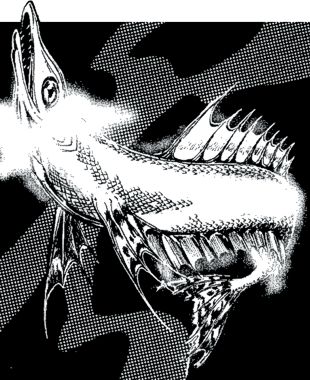

Realmspace

| Climate/Terrain: | Chandos oceans |
|---|---|
| Frequency: | Common |
| Organization: | Solitary |
| Activity Cycle: | Day |
| Diet: | Omnivore |
| Intelligence: | Animal (1) |
| Treasure: | Nil |
| Alignment: | Neutral |
| No. Appearing: | 2-8 (2d4) |
| Armor Class: | 7 |
| Movement: | Sw 15 |
| Hit Dice: | 1-1 to 4-1 |
| THAC0: | 1-1 HD: 20 ; 2-1 HD: 19 3-1 HD: 18 ; 4-1 HD: 17 |
| No. of Attacks: | 1 |
| Damage/Attack: | 1-1 HD: 1d4 ; 2-1 HD: 1d6 3-1 HD: 1d8 ; 4-1 HD: 1d10 |
| Special Attacks: | Teeth cause excessive bleeding |
| Special Defenses: | Dexterity and environment |
| Magic Resistance: | Nil |
| Size: | S-M (2-5') |
| Morale: | Average (10) |
| XP Value: | 1-1 HD: 35 ; 2-1 HD: 65 3-1 HD: 120 ; 4-1 HD: 175 |
These omnivorous fish tend to be long and thin, with a thick spiny ridge down their vertebrae. Their scales are usually dark blonde or white in color. They possess the ability to create their own light by the use of bioluminescence.
These fish are unique to the Chandos oceans, although the deepest oceans of other worlds contain fish similar to these. Continually hungry, the Chandos fish are on a never-ending search to fill their bellies. They are not picky eaters, although they do prefer a fresh kill over stagnant meat, and they prefer old meat over the fungus, algae, sponges and other plant life that inhabit the Chandos oceans.
Combat: Whenever Chandos fish find a possible dietary intake of freshly killed meat, they immediately attack it. They do not wait to eat once the prey is killed; they instead bite with full intent on removing and swallowing that bitten section of flesh. This attack form is why additional damage is inflicted on opponents whenever a feeding frenzy ensues. This added damage equates to 1 point per bite per round, until the wounds are bound.
Whenever the fish smell or taste blood, they immediately go into a frenzy similar to that of a barracuda or piranha. They swarm to where the blood is the thickest and attack all open wounds. Often, these fish attack their own kind during this frenzied attacking. When someone is first attacked by these fish, there are 2d4 fish nearby. Every six rounds thereafter, the number of fish increases by 2d10.
Habitat/Society: Chandos fish usually school together when they are young. This assures their survival and their mutual training in survival. Once they are large enough to fend for themselves, which happens at 1-1 HD, they turn solitary until it is time to breed.
Chandos fish do not have the territorial instincts that many animals have. They protect their food if the target is too small for more than one fish to consume in one meal.
Ecology: The eggs of these fish are laid in the holes and cracks of rocks, in strings extending as long as 50 feet, with over 1,000 eggs in a string. Not all eggs hatch, and not all newborn fish make it to adulthood. Out of the 1,000 eggs laid by one adult, only about 12 survive long enough to breed themselves. The current life expectancy of these fish is about three years, with the breeding age being six to eight months.
These fish are very protective of their impregnated mates. Until the female lays her eggs, the male swims by her side to protect her from all danger, real or imagined. Once the eggs are laid, they separate forever. They do not mate together again, each finding another when the time comes.
